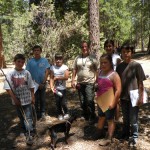Finding your way in the woods without a map or compass can be a daunting task. Yet our ancestors traveled their wild world — sometimes hundreds of miles — on foot without a breaking a sweat. How the heck did they do it?
Being guided by nature is based in reading its subtle patterns to which modern domesticated humans are often oblivious or they normally ignore them.
The directions of the world are worn into the very rocks, reflected in the undergrowth leaves reaching toward the sun and in the gnarled branches of trees twisting their way to the sky. Our ancestors could read these natural patterns as easily as you read a street sign, guiding them to their destinations and back again.
So how do we (re)train ourselves in this ancient human skill? No one fail-safe method or “trick” to natural navigation is true for every location.
Finding your way naturally relies on understanding the larger natural patterns of the area in which you live in. Examples include the amount and direction of light, prevailing wind(s) and level of moisture. These cumulative forces cause subtle asymmetries you can learn to interpret. In short, you must spend time in nature, observing and interacting.
Here are a handful of rough directional patterns to get you started:
Into the light: In an effect known as heliotropism, many plants orient themselves toward the greatest source of light. In our forest, one of the more sensitive and obvious heliotropic flora would be our lovely fiddlehead ferns.
Ferns in direct sun will tend to orient much of their growth southward to catch the most light. However, be sure to identify possible obstacles to light that might change the fern’s orientation. For example, under heavy tree cover, heliotropic plants will orient toward the nearest bright opening in the canopy, no matter what direction it is. Open meadows may be your best bet.
A tree’s heavy side: Lone trees tend to be “heavier” with more leaves and branches to the south side (in our northern hemisphere), enabling them to capture more of the life-giving Sun. Take the time to walk around the tree and view it from multiple angles. However, this effect can be muted or overridden in a grouping of trees as their shadows interact with each other.
Branching out: Sunlight also directs the growth of individual branches. Southern branches tend to grow more horizontally (toward the Sun), while the shaded northern branches tend to grow more vertically in their quest for more sunlight. This can be most easily seen when observing the tree from east to west. Once again, individual trees are easier to read than groves.
Moss and moisture: Isn’t moss supposed to grow on the north side of trees? Yes, but for the record, moss does not always grow just on the north side of trees.
Where moss grows depends mainly on the level of moisture, which is not always on the north side. Also, disregard growth in the first two feet up from the ground around the trunk because this tends to be influenced by the evaporating ground moisture.
Interested in exploring this further? An engaging guide to these skills is Tristan Gooley’s book “Natural Navigation.” There are hundreds (possibly thousands) of more tips to explore and many more of your own to discover as you go out and start looking for your own patterns in nature.










